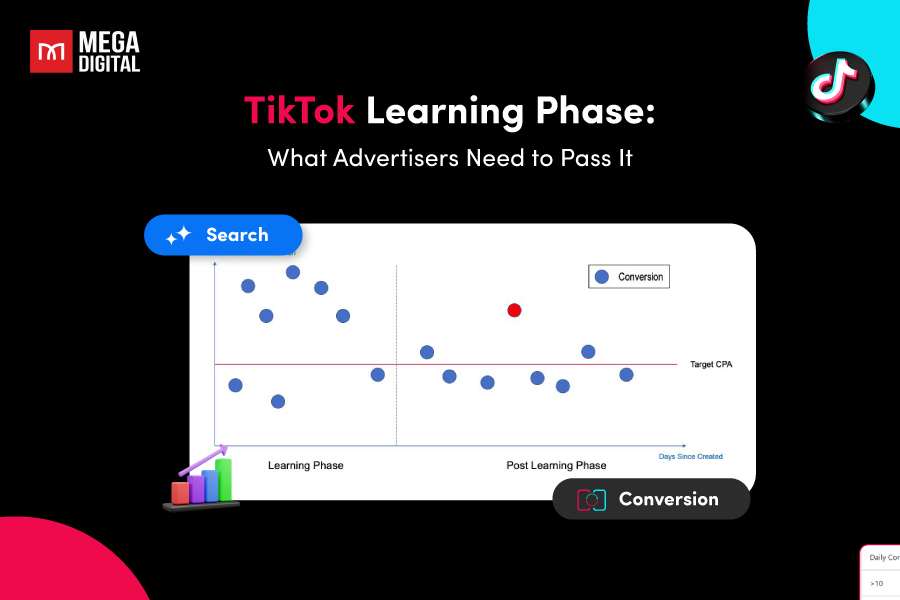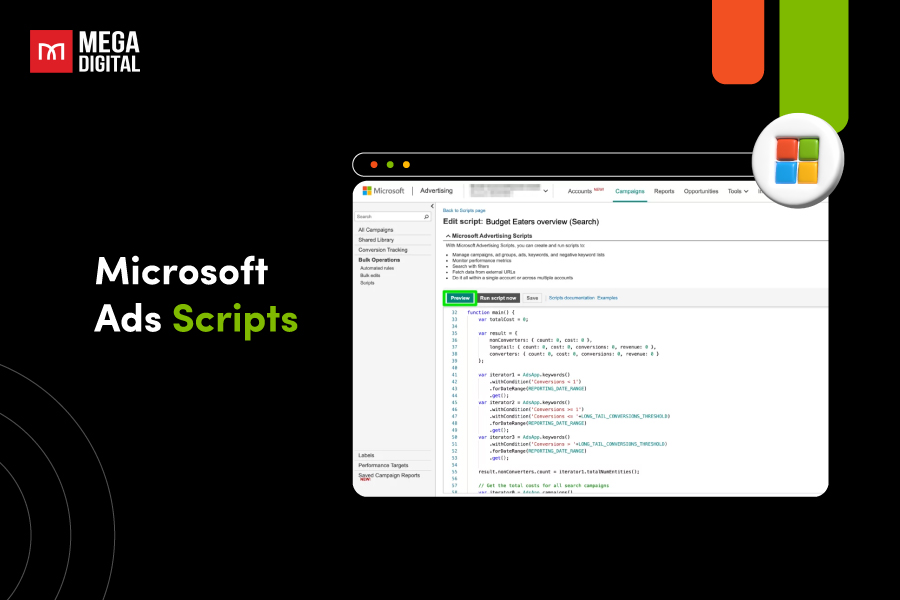You must have come across some full-screen ads that pop up just before the next page loads in apps. These are interstitial ads that help grab attention and generate conversions. In this post, we’ll explain to you this type of ads, their functions, and show you some tips to use them effectively without interrupting user experience.
Contents
What Is Interstitial Ads?
Interstitial ads are a type of advertising that covers the entire screen of an app. They appear at natural transition points in the app’s flow, like when you switch between activities or game levels.
When encountering an interstitial ad, you have a choice to close it or click to see what’s being promoted.
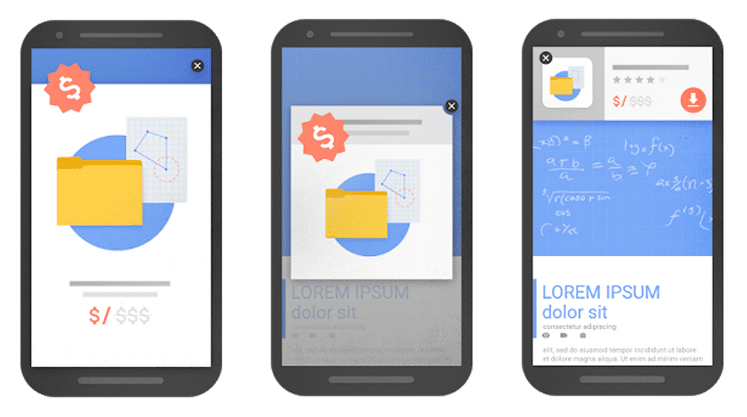
Interstitial ads should be distinguished from popup and banner ads. Popups only cover a small part of your screen. Banner ads are fixed at the top or bottom.
Meanwhile, interstitials fill the whole screen of both mobile apps and websites. They are commonly displayed during transitions, such as between game levels or during app navigation, and can appear on platforms like Pangle, Facebook, and Google Ads in order not to interrupt the flow too much.
Benefits Of Interstitial Ads
Interstitial ads offer a range of benefits for advertisers when used correctly. From increasing visibility to driving higher revenue, these ads can be a powerful tool in your marketing strategy.
1. High compatibility with mobile devices
On mobile, where the screen space is limited, interstitials make the most of that space. This means they’re hard to miss and can avoid the problem of “banner blindness” – you know, when users stop noticing small banner ads.
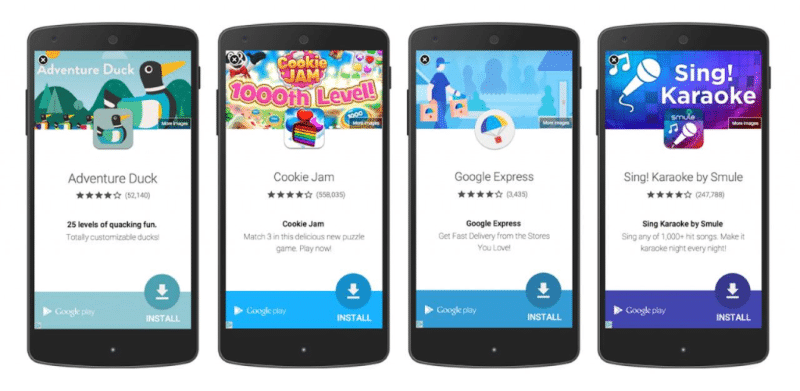
Plus, mobile devices are fast and responsive, which means interstitial ads can appear smoothly without slowing down the app. So, when users encounter them, they’re more likely to engage, making interstitials a smart choice for driving results in a mobile-first world.
2. High click-through rates (CTRs)
One of the greatest benefits of interstitial ads is their ability to improve click-through rates (CTRs). This is because these ads cover the entire screen and appear at natural breaks.
Hence, users will see them at the right moment and are more likely to take action. Whether it’s exploring a new product or checking out an offer, ads that are easier to see get more attention – and ultimately, more clicks.
3. High Ad Revenue
Thanks to high visibility and CTRs, interstitial ads often lead to higher ad revenue. When ads are more likely to be seen and engaged with, it increases values, which means more revenue for app developers and advertisers alike.
A case in point was Brighthouse’s game named “White House 4”. Brighthouse saw a big improvement in their app revenue by 130% after using the interstitial ad format. Now, these interstitial ads make up 60% of the money the app earns.
But it’s not just about size – placement matters too. Interstitials typically show up at natural pauses in app usage, which means users aren’t too frustrated by the interruption. This leads to better user experience compared to other ad types, ultimately driving up boosting revenue.
How Do Interstitial Ads Work?
The flow of interstitial ads display is simple. Let’s discover how these ads work through some stages as below:
Stage 1. Triggers
Interstitial ads don’t just appear randomly. They’re strategically triggered at key moments in the app. You can avoid interrupting the users’ flow with interstitial ads, making it feel more like a part of the experience.
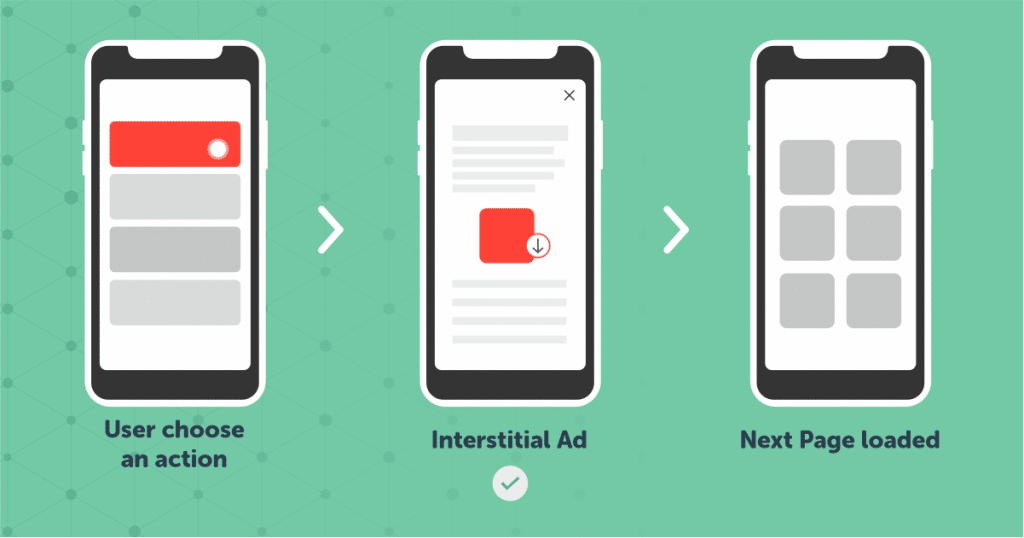
When a user visits your website or app, a publisher’s ad exchange (such as Google AdX) for an interstitial ad will receive a request. The ad exchange then detects the user’s device screen size and sends this information with the ad request to advertisers.
Stage 2. Full-Screen
Once the ad is triggered, it takes over the whole screen. The ad platform must determine the size of the user’s screen to fit the full page. Unlike smaller banner ads, the interstitial ad gets noticed, since it can’t be missed.
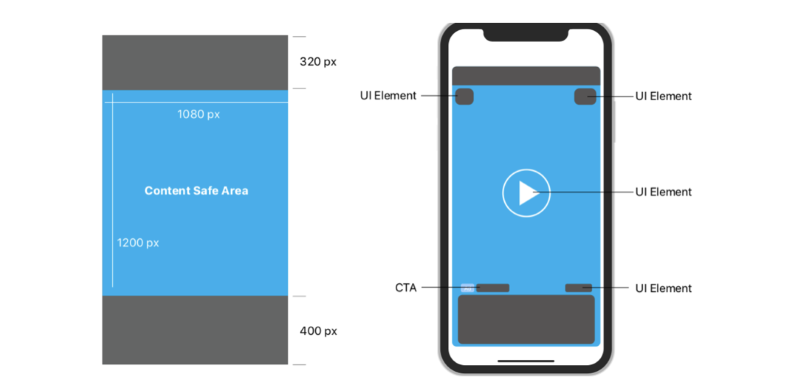
To own a spot on the available screen space, advertisers must respond to the ad exchange’s request and submit their bids to the platform. They can use any size creatively, as long as it stays within 50% of the screen width and 40% of the screen height. The advertiser who offers the most for the placement wins the chance to display the ad on the user’s screen.
Stage 3. User Interaction
Once the full-screen ad appears, users have the option to interact with it. This could mean clicking on the ad to visit a landing page or heading to the app store to download something.
For example, you’re reading an adventurous story on Wattpad. After finishing a chapter, you see an ad for an adventure game popping up. The ad shows an interactive trial and offers a download for a full experience. Since you’re already in a storytelling mindset, the game ad feels like a natural fit to dive into another adventure.
>>>> Read more: 15+ Best Native Ads Platforms To Boost Ad Revenue in 2025
Stage 4. Timeout
After an interstitial ad appears, it won’t last for too long. There’s a set timeout before a close button shows up, allowing users to exit the ad if they’re not interested.

This limited display time is crucial to keep users from feeling trapped, as they know they’ll have the option to close it soon. Besides, because users know they can close the ad shortly, they’re more likely to focus on it instead of leaving for another app.
Frequency limits are also essential. Nobody wants to see the same ad repeatedly, so interstitial ads are usually limited by how often they appear within a session. This balance helps avoid frustration and keeps users more open to engaging with ads when they do appear.
Types Of Interstitial Ads
You can use a mix of several types of interstitial ads to capture user attention. There are several ad formats to improve your advertising strategies as below:
1. Image Interstitial Ads
These ads might include simple product images or more complex graphics and illustrations.
It’s a good idea to use two images for interstitial ads. Since ads can appear differently depending on the user’s browser and device, using two images can help prevent any awkward or blank spaces from showing up, which can happen if only one image doesn’t fully fit the display.
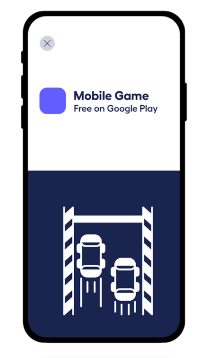
For best results, aim to use an icon image with a 256×256 resolution and a banner with a 900×600 resolution.
2. Video Interstitial Ads
Video interstitial ads create a more engaging experience for users. These ads generally show product demonstrations, storytelling narratives, or short entertainment clips.
For instance, TikTok displays short interstitials video ads through a format of In-Feed ads or TopView ads. Interstitials appear as In-Feed ads within the user’s scrolling experience while TopView takes over the screen when users first open the app.

3. Interactive Interstitial Ads
Interactive interstitials take user engagement to the next level by enabling users to interact with the ad display.
Instead of just watching, users play mini-games and try out interactive demos, or simulations designed to provide a two-way communication channel. While users are actively involved in the experience, the platform gains valuable insights.
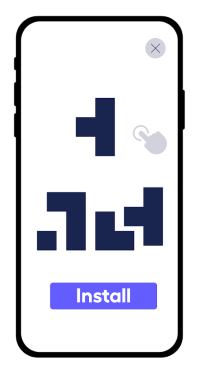
This type of interstitial ads is often used in gaming apps as they enable players to experience a trial of the game before deciding to download it.
How Much Can You Earn from Interstitial Ads?
The amount you earn depends on the type of game you place your ads in. Some games generate about 50%-100% of their revenue from ads, while others make money from in-app purchases (IAP). The revenue source varies across different game genres.
Interstitial ads can be a useful tool for making money from your app if it is carried out well. In top-tier markets, developers can anticipate average eCPMs of $7.03 to $15.30 by integrating playable and video interstitials. The eCPM for standard interstitial advertisements typically falls between $5.55 and $8.59.
How to Set up Pangle Interstitial Ads?
Setting up Interstitial Pangle Ads TikTok can be a great way to reach a broader audience and increase engagement. Here’s a guide to help you get started with the process.
Prerequisite:
Set up an app and interstitial Ad Placement on the Pangle platform.
- To add your app to Pangle, navigate to [Application] -> [App] -> [Add App].
- To set up interstitial ad placements, go to [Application] -> [Ad Placements] -> [Add Ad Placement] -> [Interstitial Ads].
Step 1: Request the Ad
You must send a request to Pangle for the ad, which is compulsory to obtain permission to display the ad within your app.

Step 2: Load The Ad
Then, you have to prompt your app to contact and fetch the interstitial ad from Pangle. This step helps load the ad into your app and ensure it’s ready to be displayed when needed.

Step 3: Create Ad Events
- Ad Loaded: Set up a listener to notify you once the ad has loaded and is ready to be displayed.
- Ad Clicked: If you want to know when the ad is clicked, you can set up a listener to handle user interactions.
- Ad Closed: When users close the ad, your app can take appropriate next steps if you set up a listener to detect it.

Step 4: Show the Ad
After loading, display the ad to users. You can show it in different types such as image, videos or interactive ads.
Interstitial Ads Best Practices
To get the most out of interstitial ads, it’s important to follow best practices that ensure a smooth user experience while driving engagement. Let’s go over some key strategies to make your interstitial ads both effective and non-disruptive.
1. Focus on User Experience
When positioning interstitial ads, remember that they work best in linear user experiences, where your app has clear start and end points. Are there natural pauses in your app’s flow? That’s where interstitials can fit well, making the ads flow more natural.
A good spot for these ads, according to Google AdMob, is before a “Break” page – a transition page where users typically tap the “next” or “continue” button. Ads that pop up immediately after that button click can make users feel annoyed, causing unintentional ad clicks and lowering your conversion rates.
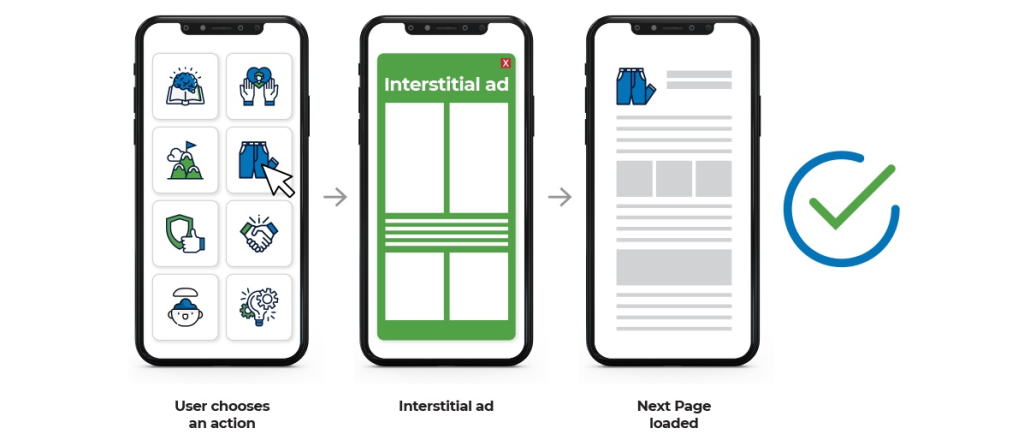
Then, while the ad is playing, remember to pause all in-app actions, like background audio or heavy processing tasks. This prevents slowdowns and keeps your app’s graphics and video running smoothly.
2. Direct Users to a Landing Page
If users get interested and eventually click on your ad, how to guide them toward the intended action?
Instead of directing users to a general brand website, advertisers should consider building post-click landing pages optimized for converting new customers. Unlike a generic homepage, landing pages focus on a single call to action (CTA) and help eliminate distractions.
With careful execution, a landing page can make it easier to match user expectations and boost conversion rates.
3. Design a Timeout Feature
While keeping users focused on your ad is crucial, you should not trap them in it for too long. Remember, they don’t choose to watch it, so to be respectful, you must offer an easy way out.

You should avoid forcing them through long videos or hiding the “X” button. Instead, you can follow these practices:
- Make the “timeout” length clear for about 5 to 10 seconds.
- Allow users to skip the ad when possible.
- Ensure the exit button is visible and easy to find, not hidden by colors or objects.
Interstitial Ads Examples
1. App Installation
Interstitial ads work well for cross-promoting other apps too. For example, a gaming app might show an interstitial ad for another game from the same developer.
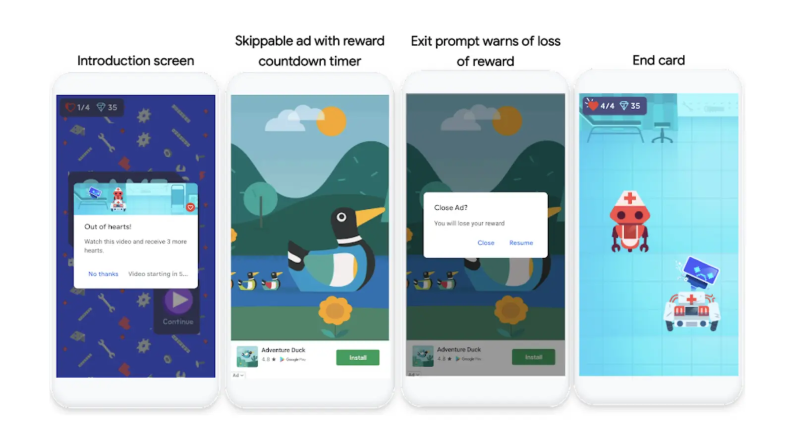
This approach can be powerful if the recommended app aligns with the user’s interests.
Adventure Duck is a great example of interstitial ads in a recent campaign. After a user loses a level, they’re offered an interactive game ad to earn more lives, with a suggestion to download the app if users find it interesting.
2. Seasonal Campaigns
Interstitial advertising are a great way to promote seasonal campaigns or special offers during holidays.
For a holiday sale or limited-time discount, a shopping app might show an interstitial ad, mostly featuring an image of well-known influencers. These ads create urgency and encourage users to jump on these deals.
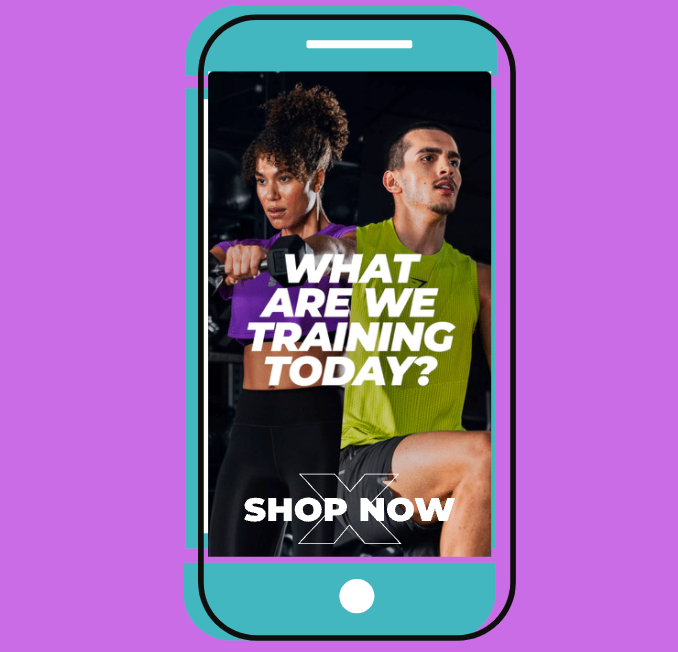
3. Survey Participation
To have more people participate in surveys, you can use interstitial ads displayed on social media apps such as TikTok.
For instance, an ad can invite users to take a short survey for a reward like a product discount. You can add some call-to-action buttons such as “Learn More” or “Sign Up” to direct viewers to the survey when they click.
Furthermore, it is important to ensure that the ad description shows a clear and concise message.
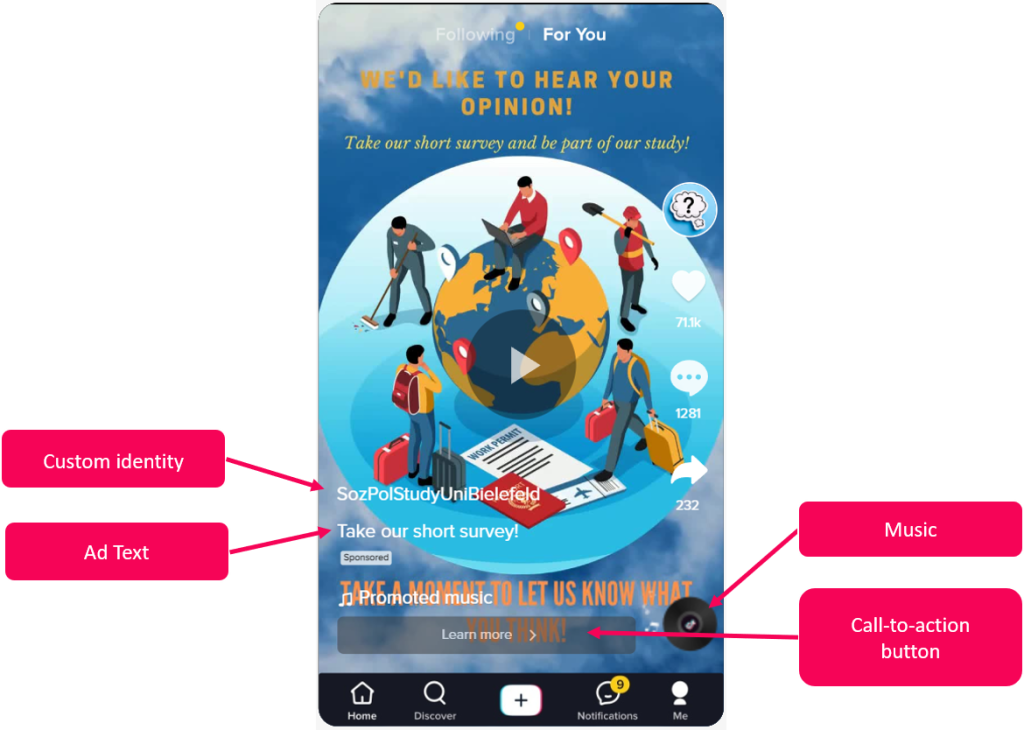
Wrap up
For advertisers, interstitial ads with full-screen content provide a great opportunity to captivate users.
As a beginner, knowing the best practices can make it possible to effectively utilize ads without annoying the users. Always bear in mind that timing and relevancy are key. Interstitial ads that are carried out thoroughly can boost engagement and conversions without disrupting the user experience. Try out interstitial ads now to add an important resource to your digital marketing strategies!







